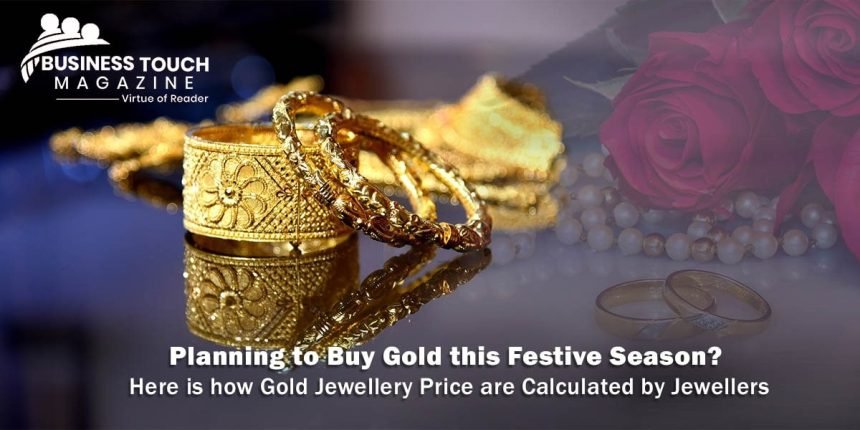During the Indian festivals of Akshaya Tritya, Dhanteras, and Diwali, it is customary to purchase gold in the form of jewellery, coins, etc. We spend hours at the jeweller’s picking precisely what we want, yet we seldom question the price. I really disagree with you on this. You shouldn’t take the jeweller’s pricing at face value since there are several variables (gold price, making fees, gem value, etc.) that may significantly change the final price.
There is no national standard for pricing, so consumers must shop around for jewellery. “There is no uniform invoicing pattern in the nation, and the billing method differs from one jeweller to the next,” says Sandeep Kulhalli, senior vice president – retail and marketing, jewellery business, Titan Company. Gold prices vary from city to city since each has its own jewellery organisation, whose members proclaim the day’s gold rate each morning.
Atul Sinha, senior vice president of marketing at Caratlane, explains the formulas jewellers use to set prices:
Final price of the jewellery = Price of (22 KT or 18 KD gold X (Weight in grams) + Making charges + GST at 3% on (Price of jewellery + making charges)
The below example can help you understand this better.
Suppose the price of gold listed by the jeweller is Rs. 27,350 for 10 grams of 22KTgold. Now, if you wish to purchase a gold chain of 9.6 grams, then price will be calculated as follows:
Price of 1 gram of gold = Rs 27,350 divided by 10 = Rs. 2,735
Price of 9.60 grams’ gold chain = Rs 2,735 times 9.60 grams = Rs 26,256
Add making charges, suppose 10 per cent, which comes to Rs 2,625.60 (10% ofRs 26,256)
Total price of jewellery = Rs 28,881.60 (price of 9.60 grams gold chain plus making charges)
Add GST at 3%: Rs 866.44 (3% of Rs 28,881.60) and hallmarking charge at Rs 35
The final billing be Rs 29,783.04 (Rs 26,256 + Rs 2,625.60 + Rs 866.44 + 35)
Here are a few things you should be aware ofwhile buying gold to avoid being tricked.
Studded jewellery
We sometimes purchase jewellery that has stones set into it. Some dishonest jewellers will charge you the price of gold regardless of how much of the metal is really used. According to Sinha, if you ever wanted to sell it back or trade it in, the jeweller would take into account the stone’s weight and any imperfections before deciding how much to offer you.
“For a studded item, the invoicing process is different. When a consumer buys a piece of jewellery that is studded, the cost of the stones is included in the total price “To explain, here is Kulhalli.
Knowing that the value of gold in a piece of jewellery is determined by the total weight of the item less the weight of diamonds and gemstones is important prior to making a purchase. Diamonds and gemstones should be calculated individually.
Purity of gold
There is a wide range of Karats available for gold jewellery (KT). The purity of gold is measured in karats. To which Sinha explains, “Avoid using the term “carat” in the wrong context. The weight of a diamond is expressed in carats “.
The softness of 24 karat gold prevents it from being utilised in jewellery. Gold jewellery is most often seen in the 22KT variety, which comprises 91.6% pure gold. Gold is made more robust and long-lasting when alloys like zinc, copper, cadmium, and silver are mixed in. In most cases, diamond jewellery will be set in 18 karat (KT) gold. It’s made of 75% pure gold.
Sinha elaborates by saying that the alloys chosen and their ratios affect the hue of the gold. For white gold, an additional alloy of palladium is used, while for rose gold, an additional alloy of copper is used.
Pricing of gold
Whether a piece of gold jewellery is 22 karat (KT) or 18 karat (Kt) and the kind of metal used to combine it with determines how much it will cost.
“The price of gold fluctuates daily based on market forces such as supply and demand. Most news outlets and websites will regularly report on the national pure gold rate. However, the price of gold fluctuates from one jeweller to the next depending on where the gold is being purchased and at what rate. There is typically not much of a price difference, “Sinha asserts.
According to Kulhalli, the primary reason for the wide range in jewellery costs is the fluctuation in the purchasing and selling rates of gold. According to him, “most jewellers prefer to have various rates when purchasing and selling.”
What’s more, Sinha says, “Without the addition of manufacturing costs and GST, the cost of gold (based on purity) and alloys used in jewellery creation would be the only cost factor.
However, the expense of incorporating these alloys into pure gold is negligible, often amounting to little more than three percent of the value of the pure gold used in the jewellery.”
He explains this with an example:
If the price of gold is Rs 3,300 per gram then the cost of 22KT gold would be Rs 3300 X 22/24 = Rs. 3025 per gram. However, alloys are also added to make jewellery stronger. The cost of these can range between Rs 30 and Rs 60 per gram. Hence the retail price for 22 kt gold will be Rs 3025 + Rs 60 = Rs 3085 per gram.
Making charges
Costs associated with production will vary based on the specific piece of gold jewellery you want. Reason being, each ornament has its own specific cutting and polishing needs. How much attention to detail the design calls for also depends on whether it was manufactured by hand or by machine. Machine-made jewellery is often more affordable than handmade pieces.
According to Kulhalli, “Making charges are referred to in various ways by each jeweller. The phrase “wastage” is sometimes used, whereas “making charges” is used by certain jewellers. Both a percentage of the gold’s worth and a flat making charge per gramme are acceptable formats for making charge quotations.
At most jewellery stores, the making fee is negotiable. According to Kulhalli, this is feasible since there is no universally accepted proportion for these costs among jewellers.
Additionally, he says, “Even at the same jewellery shop, the price that the salesperson provides will differ from the discount that the store manager offers. This kind of billing does not provide the client with any clear information.
According to Sinha, “A consumer may never get to know whether they have negotiated sufficiently. Another buyer who is willing to haggle may be able to purchase the identical item for a lesser price. Sinha suggests shopping around for the best deal since the fees associated with the purchase of gold might vary somewhat from market to market. Customers benefit more from flat making charges when gold prices are rising and from percentage-based making charges when gold prices are decreasing.
BIS Standard hallmark for purity
Gold jewellery must be hallmarked to prove its authenticity and quality. The Bureau of Indian Standards (BIS) performs hallmarking as an assurance of the gold’s purity.
Gold will need to be hallmarked beginning on June 16th, 2021. Moreover, the government has updated hallmarking signs from July 1, 2021. Gold jewellery now has three markings: the BIS emblem, a purity/fineness grade, and a 6-digit, individually-generated alphanumeric number.
Kulhalli advises buyers to check four things before purchasing gold jewellery: the item’s purity, the jeweller’s return policy, the length of the guarantee, and the itemised cost.




